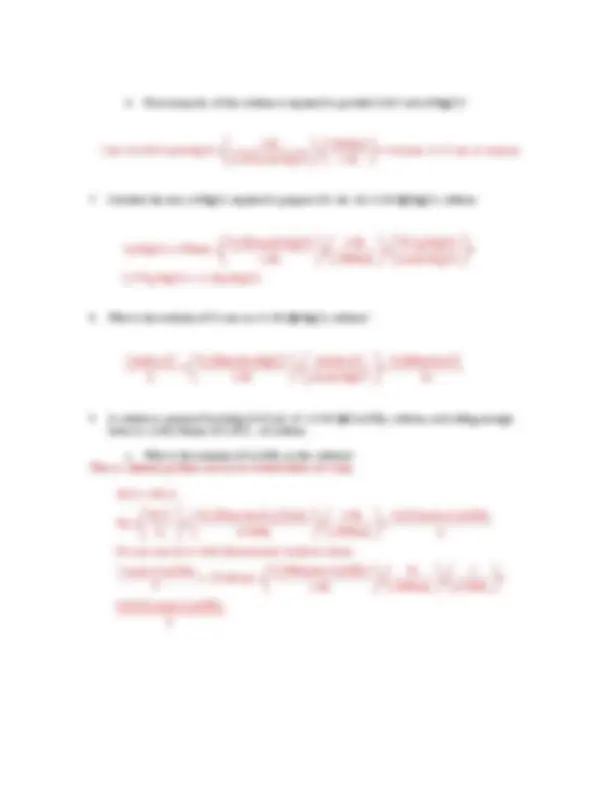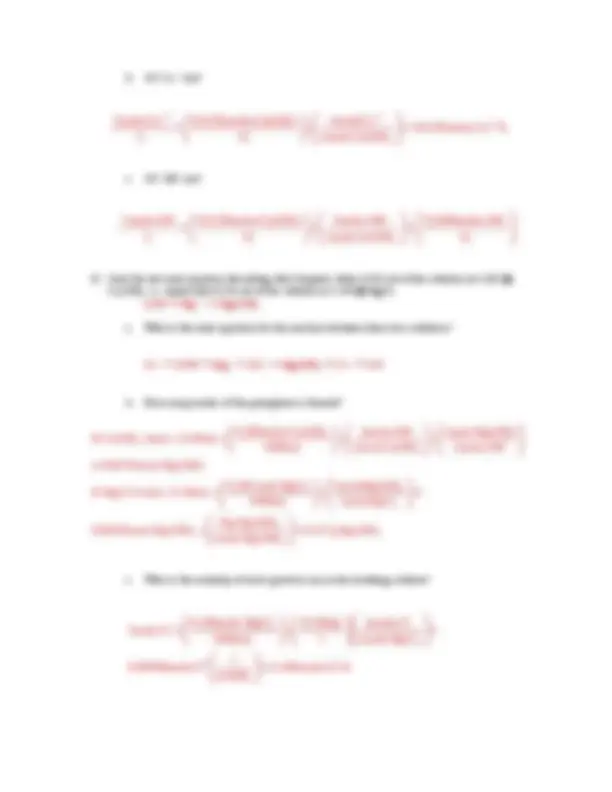





Study with the several resources on Docsity

Earn points by helping other students or get them with a premium plan


Prepare for your exams
Study with the several resources on Docsity

Earn points to download
Earn points by helping other students or get them with a premium plan
Community
Ask the community for help and clear up your study doubts
Discover the best universities in your country according to Docsity users
Free resources
Download our free guides on studying techniques, anxiety management strategies, and thesis advice from Docsity tutors
A worksheet from chapter 4 of a chemistry textbook covering topics on precipitation reactions, acids and bases, and molarity. It includes exercises on identifying oxidation numbers, writing net ionic equations for precipitation reactions and acid-base reactions, and calculating molarities and volumes of solutions.
Typology: Assignments
1 / 6

This page cannot be seen from the preview
Don't miss anything!




CH 221—Ziegler Chapter 4 WORKSHEET Precipitation, Acids and Bases, and Molarity
Zn Zn= 0
Pb(NO 3 ) 2 Pb= +2; N= +5; O= -
Zn(NO 3 ) 2 Zn= +2; N= +5; O= -
Cu + 2AgNO 3 Æ 2Ag + Cu(NO 3 ) 2
Cu loses electrons to form Cu+2^ ; Ag+^ gains electrons to form Ag Cu is oxidized, and is the reducing agent Ag+^ is reduced, and is the oxidizing agent.
Mg + Ca(OH) 2 Æ Ca + Mg(OH) 2
Mg loses electrons; Ca+2^ gains electrons Mg is oxidized, and is the reducing agent. Ca+2^ is reduced, and is the oxidizing agent.
2AgCl + Co Æ CoCl 2 + 2Ag
Ag+^ gains electrons; Co loses electrons to form Co+ Co is oxidized, and is the reducing agent. Ag+^ is reduced, and is the oxidizing agent.
Cu + Zn+2^ Æ Zn + Cu+
Cu loses electrons to form Cu +2; Zn+2^ gains electrons to form Zn Cu is oxidized, and is the reducing agent. Zn+2^ is reduced, and is the oxidizing agent.
a. KCl and AgNO 3
Ionic: K+^ + Cl-^ + Ag+^ + NO 3 -^ → K+^ + AgCl (^) (s) + NO 3 -
Net ionic: Cl-^ + Ag+^ → AgCl(s)
b. NaOH and MgCl 2
Ionic: 2Na+^ + 2OH-^ + Mg+2^ + 2Cl-^ → Mg(OH) 2 + 2Na+^ + 2Cl-
Net ionic: 2OH-^ + Mg+2^ → Mg(OH)2(s)
c. Fe 2 (SO 4 ) 3 and BaCl 2
Ionic: 2Fe+3^ + 3SO4-2^ + 3Ba+2^ + 6Cl-^ → 2Fe+3^ + 6Cl-^ + 3BaSO4(s)
Net ionic: Ba+2^ + SO4-2^ → BaSO4(s)
d. KCl and Mg(NO 3 ) 2
Ionic: 2K+^ +2Cl-^ + Mg +2^ + 2NO 3 -^ → 2 K+^ + 2NO 3 -^ + Mg+2^ + 2Cl-
Net ionic: NO REACTION
Ionic: 2HF + Ca+^ + 2OH-^ → 2H 2 O + Ca+2^ + 2F- Net ionic: HF + OH-^ → H 2 O + F-
b. H 2 SO 4 + Mg(OH) 2 Æ 2H 2 O + MgSO4(aq)
Ionic: 2H+^ + SO 4 -2^ + Mg(OH) 2 → 2H 2 O + Mg+2^ + SO 4 -
Net ionic: 2H+^ + Mg(OH) 2 → 2H 2 O + Mg+
b. How many mL of this solution is required to provide 0.0367 mol of MgCl 2?
2 2
1.0L 1000mL ? mL 0.0367mole MgCl 146.6mL 147 mL of solution 0.250 mole MgCl 1.0L
x x
2 2 2 2
2 2
2 - a. What is the molarity of Ca(OH) 2 in this solution? This is a dilution problem and can be worked either of 2 ways:
1 1 2 2
1 1 2 2 2
2 2
2
b. Of Ca+2^ ion?
+2 + (^2) +
2
c. Of OH-^ ion?
2 2
a. What is the ionic equation for the reaction between these two solutions?
Ca+2^ + 2OH-^ + Mg+2^ + 2Cl-^ → Mg(OH) 2 + Ca+2^ + 2Cl-
b. How many moles of the precipitate is formed?
2 2
0.300moles Ca(OH) 2moles OH 1mole Mg(OH) If Ca(OH) limits : 25.00mL 1000mL 1mole Ca(OH) 2moles OH 0.00750mole Mg(OH)
0.100 mole MgCl 1moleMg(OH) If MgCl2 limits: 25.00mL 1000mL 1moleMg
x x x
x x
2 2 2 2
Cl
58g Mg(OH) 0.00250mole Mg(OH) 0.437g Mg(OH) 1mole Mg(OH)
x
c. What is the molarity of each spectator ion in the resulting solution?
−